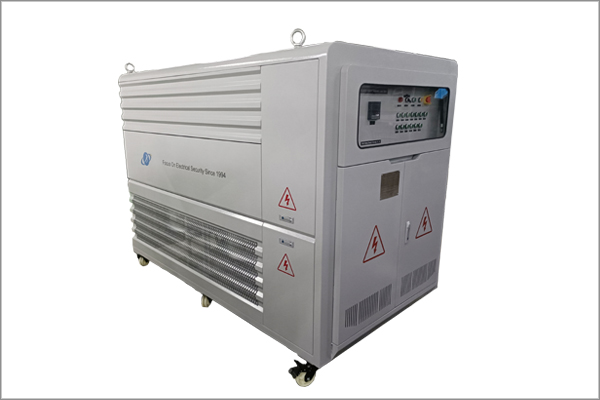AC Load Banks - Functionality and Applications
Time:2025-07-07
Introduction
In the realm of electrical power systems, ensuring reliable and efficient operation is of utmost importance. AC load banks play a crucial role in achieving this goal. They are devices designed to simulate electrical loads, allowing for the testing and evaluation of power sources such as generators, uninterruptible power supplies (UPS), and electrical distribution systems. By subjecting these systems to realistic load conditions, AC load banks help identify potential issues, optimize performance, and ensure the safety and reliability of power infrastructure.
How AC Load Banks Work
AC load banks are typically composed of resistors, inductors, and capacitors, which are used to create different types of electrical loads. Resistive loads are used to simulate the power consumption of devices such as heaters and incandescent lights, while inductive loads mimic the behavior of motors and transformers. Capacitive loads, on the other hand, are used to simulate the power factor correction requirements of certain electrical systems.
The operation of an AC load bank is controlled by a control panel, which allows the user to adjust the load settings and monitor the performance of the power source. The control panel may also include features such as over - current protection, over - temperature protection, and voltage regulation to ensure the safe and reliable operation of the load bank.
Types of AC Load Banks
There are several types of AC load banks available on the market, each designed to meet specific application requirements. Some of the most common types include:
Resistive Load Banks: These load banks consist only of resistors and are used to test the ability of a power source to supply real power. They are typically used for applications where the power factor is not a critical factor, such as testing the output of a generator or the performance of a UPS under resistive loads.
Inductive Load Banks: Inductive load banks contain inductors in addition to resistors and are used to simulate the reactive power requirements of electrical systems. They are commonly used to test the performance of generators and UPS systems under inductive loads, such as motors and transformers.
Capacitive Load Banks: Capacitive load banks are designed to simulate the capacitive reactance of electrical systems and are used to test the power factor correction capabilities of power sources. They are often used in applications where a leading power factor is required, such as in some industrial processes.
Combined Load Banks: These load banks incorporate resistors, inductors, and capacitors, allowing for the simulation of complex electrical loads with different power factors. They are the most versatile type of AC load bank and can be used for a wide range of applications, including the testing of power systems in data centers, hospitals, and industrial facilities.
Applications of AC Load Banks
AC load banks find applications in various industries and sectors, some of which are as follows:
Power Generation: In the power generation industry, AC load banks are used to test and commission generators. By subjecting the generators to different load levels, operators can ensure that the generators are capable of delivering the required power output and that their control systems are functioning properly. Load banks are also used to perform routine maintenance checks on generators, such as load - testing to prevent issues like wet - stacking (a problem in diesel generators where unburned fuel accumulates due to light loading).
Data Centers: Data centers rely on a reliable power supply to keep their servers and other critical equipment running. AC load banks are used in data centers to test the performance of UPS systems and electrical distribution systems. By simulating the actual load requirements of the data center, load banks help ensure that the power infrastructure can handle the load during normal operation and in the event of a power outage. This is crucial for maintaining the availability and integrity of data stored in the data center.
Healthcare Facilities: Hospitals and other healthcare facilities require a continuous and reliable power supply to support life - saving equipment and critical medical procedures. AC load banks are used to test the emergency power systems in healthcare facilities, such as backup generators and UPS systems. Regular testing with load banks helps ensure that these systems will function properly when needed, providing a seamless transition to backup power in case of a mains power failure. This is essential for the safety and well - being of patients.
Industrial Manufacturing: In industrial manufacturing plants, AC load banks are used to test the electrical systems that power manufacturing equipment. By simulating the load requirements of the equipment, load banks help identify potential problems with the power supply, such as voltage drops or instability. This allows manufacturers to take corrective measures before the problems cause production disruptions or damage to the equipment.
Conclusion
AC load banks are essential tools in the electrical power industry, enabling the reliable testing and evaluation of power sources and electrical systems. Their ability to simulate different types of electrical loads makes them invaluable in a wide range of applications, from power generation and data centers to healthcare facilities and industrial manufacturing. By using AC load banks, operators can ensure the safe, efficient, and reliable operation of their power infrastructure, minimizing the risk of power outages and equipment failures. As the demand for reliable power continues to grow, the importance of AC load banks in maintaining the integrity of electrical systems will only increase.
News Recommendation
-
 2024-09-11
2024-09-11TRIUMPH LOAD EXHIBITING AT Enlit Europe 2024 -BOOTH 7.H08
-
 2023-04-21
2023-04-21TRIUMPH LOAD EXHIBITING AT DATA CENTER WORLD GERMANY 2023-BOOTH F909
-
 2023-04-06
2023-04-06TRIUMPH LOAD EXHIBITING AT ELECTRIC POWER TECH KOREA 2023 – Booth G109
-
 2022-05-05
2022-05-05What is the role of ac load bank for power supply?
-
 2022-05-05
2022-05-05What is the role of the load bank?


